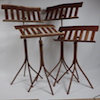I'm working on some frames for some small step-stools. These are simply made from 1x2" poplar with 6x30 dominos at the joints. The steps that I'll be adding later will be small 1" thick (a true 1") pieces of elm from a tree I had milled a couple years ago.
I realize I could buy some CA glue (or devise another option) to temporarily glue on some small angled pieces to the sides so that I could properly affix clamps to this assembly while the glue sets, but rather than going that far, I'm curious what thoughts people on this forum have about simply forgoing clamping all together.
For what it is worth, the dominos are very tight on both sides of each joint, I'm using titebond III, and when I push the parts together, they fit together nice and snug.
Would clamping this up during the glue up really make this a substantially stronger joint, or not?
IMG_7452.jpg
IMG_7453.jpg
IMG_7454.jpg




 Reply With Quote
Reply With Quote










